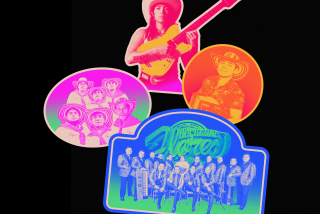Mexico’s ‘I’m No Longer Here’ turns its lens on street gangs with style and moves
Mexican writer-director Fernando Frias de la Parra set his latest film, “I’m No Longer Here” (Ya no estoy aquí), among the music and dance culture of northern Mexico’s street gangs. Members of this urban tribe, referred to as cholombianos or kolombias, share a similar style of dress (oversized clothing inspired by the American cholo aesthetic), extravagant hairdos (long sideburns and prominent spikes) that almost resemble those of indigenous people in pre-Hispanic times. And most important, elaborate dance moves, requiring excellent balance.
This kolombia countercultural movement, with its embrace of cumbia rebajada music (a slow-tempo style of the Colombian music genre), emerged from an amalgamation of influences among gangs in poverty-stricken and hyper-violent settlements on the outskirts of the industrial city of Monterrey.
The tune-driven drama, Mexico’s Oscar entry for the international feature film category, follows 17-year-old Ulises (first-time actor Juan Daniel Garcia Treviño), who — somewhat like his namesake from the Greek epic — embarks on an odyssey alone to the far-off land of New York City to protect his mother and sibling from impending underworld retribution.
Though he painfully must leave behind his Terkos clique, composed of other kolombia teens, the cumbias that once united them in communal celebration travel with him. It’s a journey of self-discovery wrapped in an immigration story. Frias deliberately places the plot around 2010 and 2011, two particularly violent years in Mexico’s ongoing drug war.
“I’ve always been fascinated by cultural clashes, syncretism and youth culture in general,” Frias said. The filmmaker first became acquainted with cumbias rebajadas when a friend who’d studied in Monterrey gave him a bootleg CD with a collection of popular tracks. At that point, he didn’t connect the music style with the subculture at large.
Years later, he saw portraits of a group of kolombia kids on a glossy magazine. Removing them from their socioeconomic context, the article failed to provide much insight. “It was an article about the looks only. They took the kids out of their element and photographed them against a white backdrop. The pictures were great, but they were looked at as an oddity,” Frias said.
Interested in making a movie with them at the center, he traveled to Monterrey to meet young people from those disadvantaged communities and further understand their motivations on a personal level.
“None of the kids in the [fictional] Terkos knew each other before the movie. We found each one in a very different case. There’s no lack of talent there; what’s complicated are their life circumstances,” said the director. The production worked around their real-life needs and created spaces for them to develop their acting abilities.
“For those who are marginalized, there’s something very dignifying about being able to reinvent themselves with an identity of their choosing,” noted Frias. “When society and family have left you behind, you identify with your neighbor who is going through the same things, so you change your name for a nickname and the name of your street, or your gang becomes your last name. That’s a way of fighting back against the system that has oppressed you systematically for generations.”
Garcia Treviño, the film’s magnetic star, came on board after Frias and his team saw him and his family perform as one of the opening acts for late cumbia legend Celso Piña. Too young to have consciously experienced the peak years of the kolombia movement (late 2000s to early 2010s), Garcia Treviño didn’t initially know how to dance. After some coaching, you see him on-screen, face stoic while his body fluidly captures the rhythm for a nearly ceremonial rendition of the cumbia rebajada dance.
Despite the film’s 10 Ariel Awards from the Mexican film academy and Netflix’s global summer release earning it widespread critical acclaim, initial reactions from Monterrey’s elite, scandalized and fearful that the outside world might associate their town with kolombias, evince the classism that runs deep in Mexican society.
But the attacks didn’t discourage Frias. On social media, many have wholeheartedly embraced “I’m No Longer Here” and the counterculture it portrays. Now it’s a cultural phenomenon, so fan art on Instagram and on TikToks re-creating the scenes from the movie abound.
For Frias, the overwhelmingly positive reception to “I’m No Longer Here” resulted from audiences perceiving the honest intentions behind its making. Never exploitative, the story is seen through a respectful and affectionate gaze toward those in front of the camera. Testament to Frias’ sincerity married with honed craftsmanship is the fact that Mexico’s most famed directing trio: Guillermo del Toro, Alfonso Cuarón, and Alejandro González Iñárritu, are among the project’s biggest champions.
“[The experience] taught me that sometimes, especially in Hollywood, we only change the outer layer of the stories being told [to achieve diverse representation],” said Frias. “It’s the same story, but just with a more diverse cast, like ‘the Latino version’ of this or that. I think real representation has to do with the narrative architecture of a film, what’s shown and said, our worldview, not just telling the same stories with different colors.”
More to Read
From the Oscars to the Emmys.
Get the Envelope newsletter for exclusive awards season coverage, behind-the-scenes stories from the Envelope podcast and columnist Glenn Whipp’s must-read analysis.
You may occasionally receive promotional content from the Los Angeles Times.







